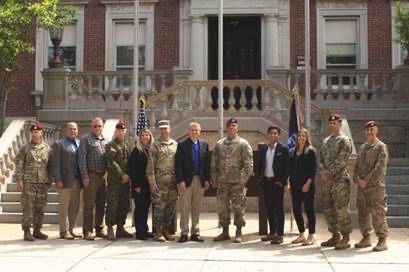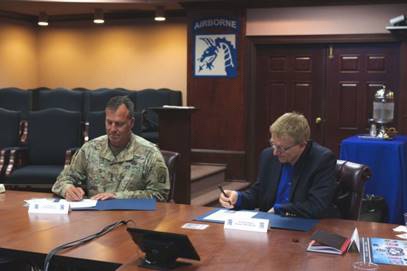FORT BRAGG, N.C. — Army scientists and engineers partnered with combat arms units to create closer working relationships between Soldiers and universities. The partnership between the U.S. Army Combat Capabilities Development Command and the XVIII Airborne Corps will help to solve military challenges, according to officials who met at Fort Bragg May 25.

As part of a new Congressional initiative called the Catalyst-Pathfinder program, the goal is to harness the creativity and technical skills of academic institutions and help the Army to quickly create better solutions to real problems.
The U.S. Army Combat Capabilities Development Command, known as DEVCOM, Army Research Laboratory manages the program in close partnership with the DEVCOM Armaments Center.
As part of the agreement, ARL and AC will work with the XVIII Airborne Corps, and specifically the 82nd Airborne Division and the 101st Airborne Divisions at Fort Bragg, North Carolina and Fort Campbell, Kentucky. to strategically engage top academic institutions and team them with Soldiers in small, integrated teams focused to solve technical problems in a highly integrated manner.
“Our role at DEVCOM’s Army Research Lab is to support the Soldier, and we have a long established relationship with the XVIII Airborne Corps,” said Dr. Patrick Baker, ARL director. “We are excited to work with them on the Catalyst-Pathfinder program to accelerate learning and science through Soldier problem identification and feedback. The teaming we are doing through the Catalyst-Pathfinder program is key to operationalizing science for Army modernization.”

Universities in North Carolina, Tennessee and West Virginia will work with the 82nd and 101st Airborne Divisions, both under XVIII Airborne Corps, to identify and rapidly solve those problems and accelerate the transition of those solutions into the Army.
“XVIII Airborne Corps fosters a culture of innovation across all ranks, giving voice and life to novel ideas that support our people, optimize our readiness, and inform Army modernization efforts,” said Brig. Gen. Robert Ritchie, XVIII Airborne Corps. “In order to field tangible solutions fast, we are partnering with ARL through the Catalyst-Pathfinder program to connect our Soldiers with the nation’s brightest academics. These Soldier-academic teams are currently empowering the 82nd Airborne Division and the 101st Airborne Division to unleash and implement creative thoughts, technologies, and equipment. Going forward, we are really excited to deepen our integration with ARL to collaboratively innovate on behalf of the Army.”
Catalyst-Pathfinder will engage Soldiers earlier in the research and development process to make them aware of emerging research and technologies that academia can provide to help meet their needs.
Catalyst frames Soldier problems in a manner suitable for academia to identify research and emerging technologies to solve them. Pathfinder executes pilot programs, rapidly accelerating the delivery of technologies to address complex Army problems. Pathfinder uses Catalyst software to curate Army problems and executes projects building Soldier-academic teams to create solutions to those problems.
At the direction of the Army Futures Command, the Catalyst program started in March 2020 with a burgeoning partnership with the 82nd and 101st Airborne Divisions. The inaugural team members developed the program framework, produced Soldier-integrated design and development training curricula, developed support tools for execution, sourced and curated Soldier challenges and project opportunities, and identified the first project with Vanderbilt University, Soldier Assistive Bionic Exosuit for Resupply, known as SABER. This effort will evaluate physiological effects on Soldiers and optimize lift-assist technology to support logistics operational challenges of Soldiers and enhance Soldier readiness.
“Establishing ARL partnerships with Army units is critical to developing scalable approaches to Army modernization,” said Dr. Arwen DeCostanza, Catalyst-Pathfinder program manager, DEVCOM ARL. “These collaborative projects will yield discoveries and future outcomes by exploiting the creativity of Soldiers, faculty, students, industry partners and the Army science and technology community.”
By U.S. Army DEVCOM Army Research Laboratory Public Affairs


Eric,
Thanks for posting this and all the other ARL related articles!
Chris ARL